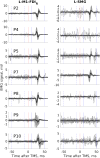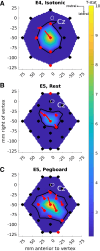Transcranial magnetic stimulation over supramarginal gyrus stimulates primary motor cortex directly and impairs manual dexterity: implications for TMS focality
- PMID: 38197162
- PMCID: PMC11551002
- DOI: 10.1152/jn.00369.2023
Transcranial magnetic stimulation over supramarginal gyrus stimulates primary motor cortex directly and impairs manual dexterity: implications for TMS focality
Abstract
Based on human motor cortex, the effective spatial resolution of transcranial magnetic stimulation (TMS) is often described as 5-20 mm, because small changes in TMS coil position can have large effects on motor-evoked potentials (MEPs). MEPs are often studied at rest, with muscles relaxed. During muscle contraction and movement, corticospinal excitability is higher, thresholds for effective stimulation are lower, and MEPs can be evoked from larger regions of scalp, so the effective spatial resolution of TMS is larger. We found that TMS over the supramarginal gyrus (SMG) impaired manual dexterity in the grooved pegboard task. It also resulted in short-latency MEPs in hand muscles, despite the coil being 55 mm away from the motor cortex hand area (M1). MEPs might be evoked by either a specific corticospinal connection from SMG or a remote but direct electromagnetic stimulation of M1. To distinguish these alternatives, we mapped MEPs across the scalp during rest, isotonic contraction, and manual dexterity tasks and ran electric field simulations to model the expected M1 activation from 27 scalp locations and four coil orientations. We also systematically reviewed studies using TMS during movement. Across five experiments, TMS over SMG reliably evoked MEPs during hand movement. These MEPs were consistent with direct M1 stimulation and substantially decreased corticospinal thresholds during natural movement. Systematic review suggested that 54 published experiments may have suffered from similar motor activation confounds. Our results have implications for the assumed spatial resolution of TMS, and especially when TMS is presented within 55 mm of the motor cortex.NEW & NOTEWORTHY Transcranial magnetic stimulation (TMS) is often described as having an effective spatial resolution of ∼10 mm, because of the limited area of the scalp on which TMS produces motor-evoked potentials (MEPs) in resting muscles. We find that during natural hand movement TMS evokes MEPs from a much larger scalp area, in particular when stimulating over the supramarginal gyrus 55 mm away. Our results show that TMS can be effective at much larger distances than generally assumed.
Keywords: corticospinal excitability; manual dexterity; mapping; movement; pegboard.
Conflict of interest statement
No conflicts of interest, financial or otherwise, are declared by the authors.
Figures











Similar articles
-
Hand perceptions induced by single pulse transcranial magnetic stimulation over the primary motor cortex.Brain Stimul. 2019 May-Jun;12(3):693-701. doi: 10.1016/j.brs.2018.12.972. Epub 2018 Dec 23. Brain Stimul. 2019. PMID: 30611706
-
High-intensity, low-frequency repetitive transcranial magnetic stimulation enhances excitability of the human corticospinal pathway.J Neurophysiol. 2020 May 1;123(5):1969-1978. doi: 10.1152/jn.00607.2019. Epub 2020 Apr 15. J Neurophysiol. 2020. PMID: 32292098
-
Towards assessing corticospinal excitability bilaterally: Validation of a double-coil TMS method.J Neurosci Methods. 2018 Jan 1;293:162-168. doi: 10.1016/j.jneumeth.2017.09.016. Epub 2017 Sep 27. J Neurosci Methods. 2018. PMID: 28962906
-
Dissecting two distinct interneuronal networks in M1 with transcranial magnetic stimulation.Exp Brain Res. 2020 Aug;238(7-8):1693-1700. doi: 10.1007/s00221-020-05875-y. Epub 2020 Jul 13. Exp Brain Res. 2020. PMID: 32661650 Free PMC article. Review.
-
A checklist for assessing the methodological quality of studies using transcranial magnetic stimulation to study the motor system: an international consensus study.Clin Neurophysiol. 2012 Sep;123(9):1698-704. doi: 10.1016/j.clinph.2012.05.003. Epub 2012 May 28. Clin Neurophysiol. 2012. PMID: 22647458 Free PMC article. Review.
Cited by
-
Concurrent tDCS-fMRI after stroke reveals link between attention network organization and motor improvement.Sci Rep. 2024 Aug 20;14(1):19334. doi: 10.1038/s41598-024-70083-5. Sci Rep. 2024. PMID: 39164440 Free PMC article. Clinical Trial.
References
MeSH terms
LinkOut - more resources
Full Text Sources
Miscellaneous

